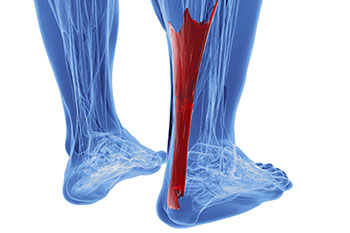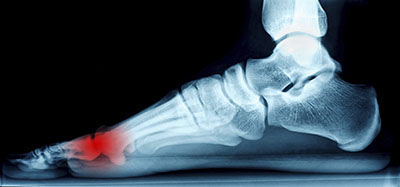
Podiatrist Stephan J. LaPointe, DPM, PhD, FACFAS of Georgia Foot & Ankle Specialists is dedicated to providing the highest quality foot and ankle care. With one office conveniently located in Rome, Georgia, Dr. LaPointe is the only podiatrist in the area board certified in both Forefoot and Rearfoot and Reconstructive Rearfoot and Ankle Surgery. He is the only podiatrist in the country with three years of surgical training and a Ph.D. in Biomedical Engineering. His thesis and focus was on lateral ankle instability and how to surgically repair it. Dr. LaPointe is a faculty member of the Podiatry Institute and is constantly lecturing on his work and research.
Dr. LaPointe provides treatment for a variety of podiatric conditions, such as heel pain and fungal nails, and offers sports medicine and surgical procedures. Georgia Foot & Ankle Specialists accepts most insurance plans and welcomes new patients! We are following the recommended guidelines of the CDC and are requiring that masks are worn when entering the office.
To schedule an appointment, call our office today! (706) 232-3888

The Achilles tendon is not only the strongest, but also the largest tendon in the human body. The main function of the Achilles tendon is to transmit power from the calf muscles to the heel and the foot.
It’s because of the Achilles tendon that we are able to stand on our toes when walking, running, or jumping. Even with all of its strength, the Achilles tendon can be exposed to injury. Due to its limited blood supply and the high tensions placed on it, the Achilles heel can be left vulnerable if harmed.
Possible conditions that may arise due to injury of the Achilles tendon include tears, ruptures, tendinitis, peritendinitis, tendinosis, tendinopathy, and bursitis. When trying to diagnose if one has issues with their Achilles tendon, a podiatrist will commonly check for any pain, swelling, or discoloration around the heel or lower leg area. Different treatments for issues concerning the Achilles tendon vary, but may include over-the-counter or prescribed pain relievers for intense discomfort, alternating ice and heat therapy, custom-made orthotics, physical therapy, and in severe cases, surgery. To help prevent injury to the Achilles tendon, it’s recommended to regularly perform stretches involving the muscles of the lower leg.
If you or someone you know is experiencing pain or discomfort involving the Achilles region, seek out the help of a podiatrist for a proper diagnosis and treatment regime.
Please note that this form is for requesting appointments only. Availability will vary and someone from our office will call you to confirm your appointment request. Please do not submit any Protected Health Information.
During the first visit, we make sure to obtain important background information, like your medical history, and give you time to get to know your doctor. We accept most insurances.
Patient Forms
Please print and fill out the New Patient forms so we can expedite your first visit.
Insurance and Payment Information
You are responsible for co-payments or charges that are not covered by your insurance. If you have questions regarding billing or which insurance plans we accept, please call (706) 232-3888. Questions regarding insurance coverage and benefits should be directed to your employer or insurance company.
Dr. LaPointe is available to treat foot and ankle ailments such as diabetic foot care, ingrown toenails, fungal toenails, warts and painful calluses. Our practice specializes in general foot care. Please call (706) 232-3888 for an appointment.

Ankle Sprains
Ankle sprains are very common injuries with more than 3 million suffered each year in the US. They occur when the ligaments in the ankle are severely stretched or torn. Medical attention will be necessary to rule out a fracture, as often it is difficult to tell the full extent of the injury.
Bunions
A bunion is a bone deformity usually occurring at the base of the big toe. This is a progressive condition that is made worse by inward pressure from tight shoes. Bunions can be very painful, and in some instances surgery may be necessary to remove them.
Flat Feet
Flat feet is a condition where the entire, or nearly entire, bottom of the foot meets the ground when standing. Depending on the severity, symptoms of flat feet can range from severe pain to non-existent.
Hammertoes
Hammertoe is a characterized by one or more of the toes having a bend in the middle joint. This occurs because of weakening of the muscle due to poorly fitted shoes or a genetically inherited trait.
Diabetes and Your Feet
Diabetes is a systemic illness that can affect many different parts of the body. This is especially true for the feet. Proper foot screening is incredibly important for diabetic patients and any kind of cut or sore should be taken very seriously.
Heel Spurs
A heel spur is a bony protrusion that occurs on the heel. It is often confused with plantar fasciitis, which is inflammation of the plantar fascia ligament. When a heel spur is painful it can make it quite difficult to walk.
Corns
Corns and calluses are hard layers of skin that usually form due to friction. Generally, they will be in areas of the foot that are bearing weight, or areas that frequently rub against the shoe. Soft corns are typically found between the toes.
Athlete's Foot
Athlete’s foot is a very common fungal infection that affects countless people around the world. It will manifest itself on the skin of the foot, in many cases in between the toes. Because fungi proliferate in warm, damp environments, keeping the feet clean and dry is of utmost importance in avoiding athlete’s foot.

Morton’s neuroma may develop when the tissue around one of the nerves leading to your foot begins to thicken. When this occurs, you may experience some discomfort as if you were standing on a pebble stuck in your shoe. Most symptoms will not appear outwardly and will be experienced in the form of a sharp, burning pain in the ball of the foot, as well as a stinging or burning feeling in the toes that may sometimes lead to numbness.
Some factors that contribute to the formation of Morton’s neuroma include wearing high heels or ill-fitting shoes that put extra pressure on your toes or the balls of your feet. There has also been a tie to the development of Morton’s neuroma and certain high-impact sporting activities. Activities you may want to avoid from participating in too frequently include both jogging and running. Too much repetitive trauma can cause a strain on the feet and increase the chances of developing a foot complication. Other sports that require the use of tightly worn shoes, such as skiing or rock climbing, may also increase your chances of getting Morton’s neuroma. Certain foot deformities can also lead to the development of Morton’s neuroma. Some of these deformities that increase the likelihood of getting this condition include bunions, hammertoes, and flat feet.
Treatment for Morton’s Neuroma will often vary, depending on the severity of a patient’s condition. In some cases, injections may be helpful for alleviating pain. Another form of treatment is decompression surgery, in which a podiatrist will work to alleviate the pressure on the nerve. In more severe cases, full removal of the nerve would be required.
If you’d like more information about Morton’s neuroma, we suggest you consult with a podiatrist for a proper diagnosis and recommended treatment plan.